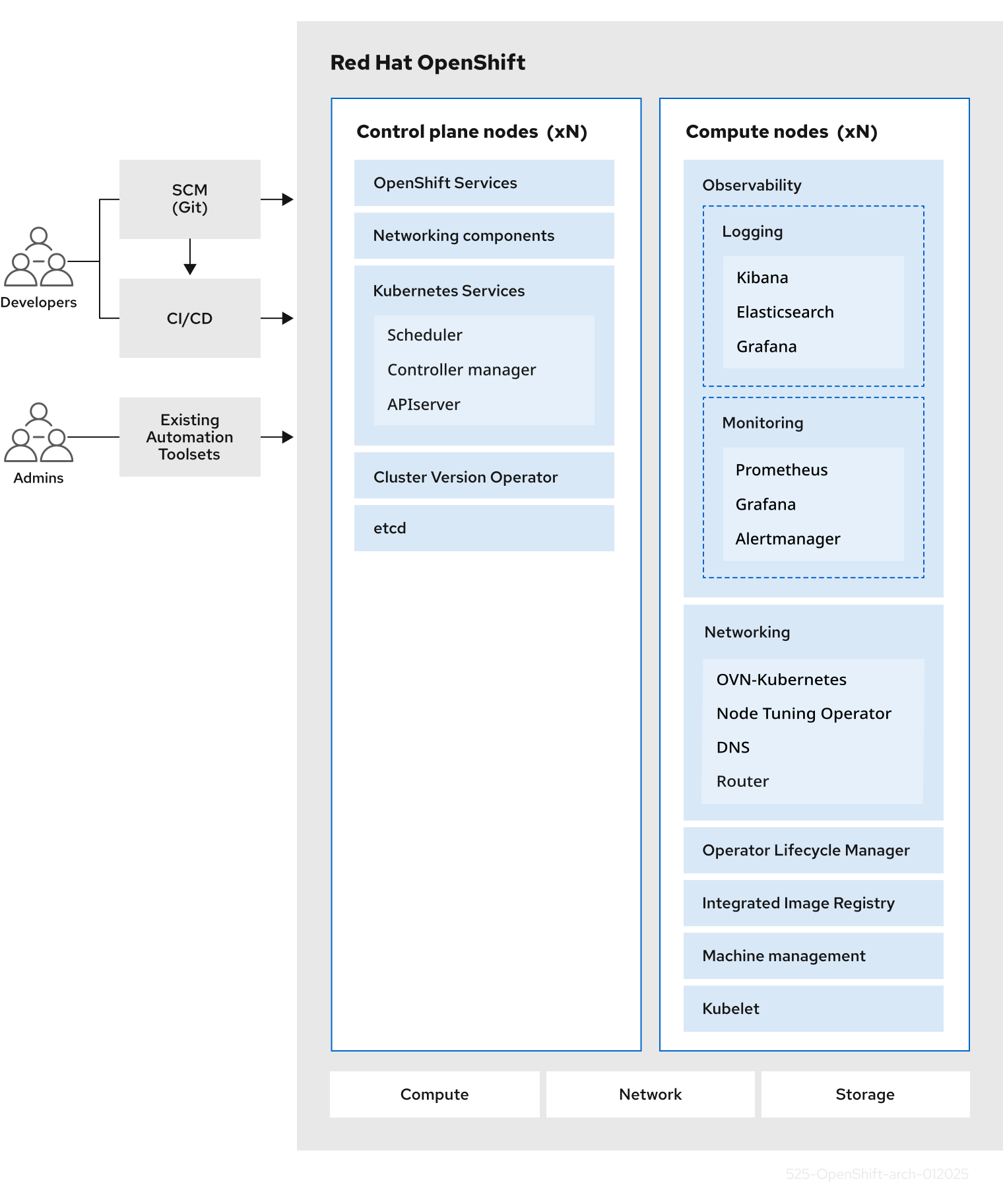第2章 OpenShift Dedicated のアーキテクチャー
2.1. OpenShift Dedicated の紹介
OpenShift Dedicated は、コンテナー化されたアプリケーションを開発し、実行するためのプラットフォームです。アプリケーションおよびアプリケーションをサポートするデータセンターで、わずか数台のマシンとアプリケーションから、何百万ものクライアントに対応する何千ものマシンに拡張できるように設計されています。
Kubernetes をその基盤とする OpenShift Dedicated には、大規模な通信、ビデオストリーミング、ゲーミング、バンキングその他のアプリケーションのエンジンと同様に機能する技術が組み込まれています。Red Hat のオープンテクノロジーに実装することで、コンテナー化されたアプリケーションを、単一クラウドを超えてオンプレミスおよびマルチクラウド環境へと拡張できます。
2.1.1. Kubernetes について
コンテナーイメージとそれらのイメージから実行されるコンテナーは、最先端のアプリケーション開発における主要な設定要素ですが、それらを大規模に実行するには、信頼性と柔軟性に優れた分配システムが必要となります。Kubernetes は、コンテナーをオーケストレーションするための事実上の業界標準です。
Kubernetes は、コンテナー化されたアプリケーションのデプロイ、スケーリング、管理を自動化するための、オープンソースのコンテナーオーケストレーションエンジンです。Kubernetes の一般的概念は非常にシンプルです。
- 1 つまたは複数のワーカーノードを使用して起動し、コンテナーのワークロードを実行します。
- 1 つまたは複数のコントロールプレーンノードからワークロードのデプロイを管理します。
- Pod と呼ばれるデプロイメント単位にコンテナーをラップします。Pod を使うことでコンテナーに追加のメタデータが付与され、複数のコンテナーを単一のデプロイメントエンティティーにグループ化する機能が提供されます。
- 特殊な種類のアセットを作成します。たとえば、サービスは一連の Pod とそのアクセス方法を定義するポリシーによって表されます。このポリシーにより、コンテナーはサービス用の特定の IP アドレスを持っていない場合でも、必要とするサービスに接続できます。レプリケーションコントローラーは、一度に実行するのに必要な Pod レプリカ数を示すもう一つの特殊なアセットです。この機能を使用すると、現在の需要に対応できるようにアプリケーションを自動的にスケーリングできます。
Kubernetes は、わずか数年でクラウドとオンプレミスに非常に幅広く採用されるようになりました。このオープンソースの開発モデルにより、多くの人々がネットワーク、ストレージ、認証といったコンポーネント向けの各種の技術を実装し、Kubernetes を拡張できます。
2.1.2. コンテナー化されたアプリケーションの利点
コンテナー化されたアプリケーションには、従来のデプロイメント方法を使用する場合と比べて多くの利点があります。アプリケーションはこれまで、すべての依存関係を含むオペレーティングシステムにインストールする必要がありましたが、コンテナーの場合はアプリケーションがそれぞれの依存関係を持ち込むことができます。コンテナー化されたアプリケーションを作成すると多くの利点が得られます。
2.1.2.1. オペレーティングシステムの利点
コンテナーは、小型の、専用の Linux オペレーティングシステムをカーネルなしで使用します。ファイルシステム、ネットワーク、cgroups、プロセステーブル、namespace は、ホストの Linux システムから分離されていますが、コンテナーは、必要に応じてホストとシームレスに統合できます。Linux を基盤とすることで、コンテナーでは、迅速なイノベーションを可能にするオープンソース開発モデルに備わっているあらゆる利点を活用できます。
各コンテナーは専用のオペレーティングシステムを使用するため、競合するソフトウェアの依存関係を必要とする複数のアプリケーションを、同じホストにデプロイできます。各コンテナーは、それぞれの依存するソフトウェアを持ち運び、ネットワークやファイルシステムなどの独自のインターフェイスを管理します。したがってアプリケーションはそれらのアセットについて競い合う必要はありません。
2.1.2.2. デプロイメントとスケーリングの利点
アプリケーションのメジャーリリース間でローリングアップグレードを行うと、ダウンタイムなしにアプリケーションを継続的に改善し、かつ現行リリースとの互換性を維持できます。
さらに、アプリケーションの新バージョンを、旧バージョンと並行してデプロイおよびテストすることもできます。コンテナーがテストにパスしたら、新規コンテナーを追加でデプロイし、古いコンテナーを削除できます。
アプリケーションのソフトウェアの依存関係はすべてコンテナー内で解決されるため、データセンターの各ホストには標準化されたオペレーティングシステムを使用できます。各アプリケーションホスト向けに特定のオペレーティングシステムを設定する必要はありません。データセンターでさらに多くの容量が必要な場合は、別の汎用ホストシステムをデプロイできます。
同様に、コンテナー化されたアプリケーションのスケーリングも簡単です。OpenShift Dedicated には、どのようなコンテナー化したサービスでもスケーリングできる、シンプルで標準的な方法が用意されています。アプリケーションを大きなモノリシックな (一枚岩的な) サービスではなく、マイクロサービスのセットとしてビルドする場合、個々のマイクロサービスを、需要に合わせて個別にスケーリングできます。この機能により、アプリケーション全体ではなく必要なサービスのみをスケーリングすることができ、使用するリソースを最小限に抑えつつ、アプリケーションの需要を満たすことができます。
2.1.3. OpenShift Dedicated の概要
OpenShift Dedicated は、以下を含むエンタープライズ対応の拡張機能を Kubernetes に提供します。
- Red Hat の統合されたテクノロジー。OpenShift Dedicated の主要コンポーネントは、Red Hat Enterprise Linux (RHEL) および関連する Red Hat テクノロジーに基づいています。OpenShift Dedicated は、Red Hat の高品質エンタープライズソフトウェアの集中的なテストや認定の取り組みによる数多くの利点を活用しています。
- オープンソースの開発モデル。開発はオープンソースで行われ、ソースコードはソフトウェアのパブリックリポジトリーから入手可能です。このオープンな共同作業が迅速な技術と開発を促進します。
Kubernetes はアプリケーションの管理で威力を発揮しますが、プラットフォームレベルの各種要件やデプロイメントプロセスを指定したり、管理したりすることはありません。そのため、OpenShift Dedicated 4 が提供する強力かつ柔軟なプラットフォーム管理ツールとプロセスは重要な利点の 1 つとなります。以下のセクションでは、OpenShift Dedicated のいくつかのユニークな機能と利点を説明します。
2.1.3.1. カスタムオペレーティングシステム
OpenShift Dedicated は、すべてのコントロールプレーンとワーカーノードのオペレーティングシステムとして Red Hat Enterprise Linux CoreOS (RHCOS) を使用します。
RHCOS には以下が含まれます。
- Ignition。OpenShift Dedicated が使用するマシンを最初に起動し、設定するための初回起動時のシステム設定です。
- CRI-O、Kubernetes ネイティブコンテナーランタイム実装。これはオペレーティングシステムに密接に統合し、Kubernetes の効率的で最適化されたエクスペリエンスを提供します。CRI-O は、コンテナーを実行、停止および再起動を実行するための機能を提供します。これは、OpenShift Dedicated 3 で使用されていた Docker Container Engine を完全に置き換えます。
- Kubelet、Kubernetes のプライマリーノードエージェント。これは、コンテナーを起動し、これを監視します。
2.1.3.2. 簡素化された更新プロセス
OpenShift Dedicated の更新またはアップグレードは、シンプルで自動化が進んだプロセスです。OpenShift Dedicated は、各マシンで実行される、オペレーティングシステム自体を含むシステムとサービスを中央のコントロールプレーンから完全に制御するので、アップグレードは自動イベントになるように設計されています。
2.1.3.3. その他の主な機能
Operator は、OpenShift Dedicated 4 コードベースの基本単位であるだけでなく、アプリケーションとアプリケーションで使用されるソフトウェアコンポーネントをデプロイするための便利な手段です。Operator をプラットフォームの基盤として使用することで、OpenShift Dedicated ではオペレーティングシステムおよびコントロールプレーンアプリケーションの手動によるアップグレードが不要になります。Cluster Version Operator や Machine Config Operator などの OpenShift Dedicated の Operator が、それらの重要なコンポーネントのクラスター全体での管理を単純化します。
Operator Lifecycle Manager (OLM) およびソフトウェアカタログは、Operator を保管し、アプリケーションの開発やデプロイを行うユーザーに Operator を提供する機能を提供します。
Red Hat Quay Container Registry は、ほとんどのコンテナーイメージと Operator を OpenShift Dedicated クラスターに提供する Quay.io コンテナーレジストリーです。Quay.io は、何百万ものイメージやタグを保存する Red Hat Quay の公開レジストリー版です。
OpenShift Dedicated における Kubernetes のその他の拡張には、SDN (Software Defined Networking)、認証、ログ集計、監視、およびルーティングの強化された機能が含まれます。OpenShift Dedicated は、包括的な Web コンソールとカスタム OpenShift CLI (oc) インタフェースも提供します。
